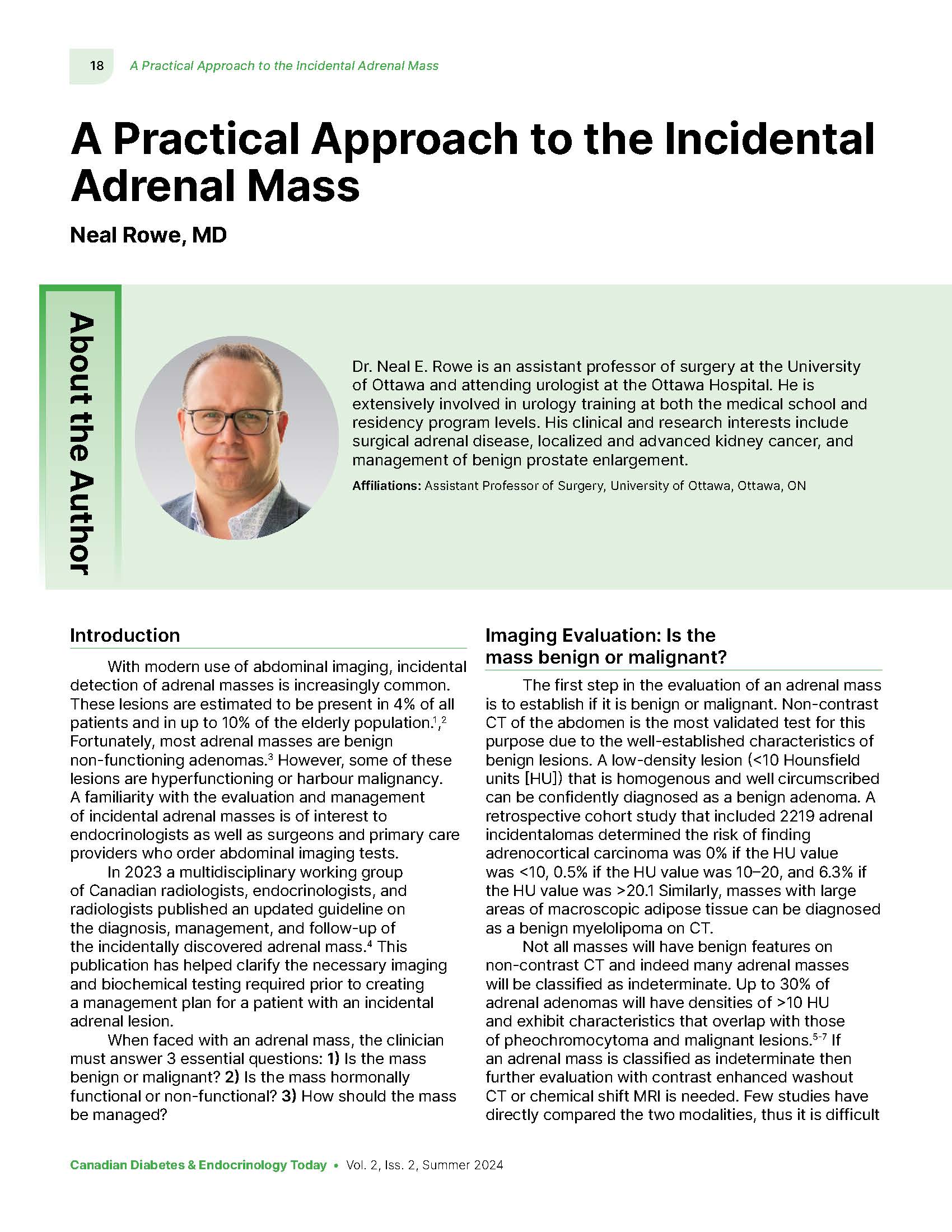A Practical Approach to the Incidental Adrenal Mass
Abstract
With modern use of abdominal imaging, incidental detection of adrenal masses is increasingly common. These lesions are estimated to be present in 4% of all patients and in up to 10% of the elderly population. Fortunately, most adrenal masses are benign non‑functioning adenomas. However, some of these lesions are hyperfunctioning or harbour malignancy. A familiarity with the evaluation and management of incidental adrenal masses is of interest to endocrinologists as well as surgeons and primary care providers who order abdominal imaging tests.
In 2023 a multidisciplinary working group of Canadian radiologists, endocrinologists, and radiologists published an updated guideline on the diagnosis, management, and follow‑up of the incidentally discovered adrenal mass.4 This publication has helped clarify the necessary imaging and biochemical testing required prior to creating a management plan for a patient with an incidental adrenal lesion.
When faced with an adrenal mass, the clinician must answer 3 essential questions: 1) Is the mass benign or malignant? 2) Is the mass hormonally functional or non-functional? 3) How should the mass be managed?
References
Song JH, Chaudhry FS, Mayo-Smith WW. The incidental adrenal mass on CT: prevalence of adrenal disease in 1,049 consecutive adrenal masses in patients with no known malignancy. AJR Am J Roentgenol. 2008 May;190(5):1163-1168. doi: 10.2214/AJR.07.2799.
Young WF Jr. Management approaches to adrenal incidentalomas. A view from Rochester, Minnesota. Endocrinol Metab Clin North Am. 2000 Mar;29(1):159-185, x. doi: 10.1016/s0889-8529(05)70122-5.
Kapoor A, Morris T, Rebello R. Guidelines for the management of the incidentally discovered adrenal mass. Can Urol Assoc J. 2011 Aug;5(4):241-247. doi: 10.5489/cuaj.11135. Erratum in: Can Urol Assoc J. 2012 Aug;6(4):244.
Rowe NE, Kumar RM, Schieda N, Siddiqi F, McGregor T, McAlpine K, et al. Canadian Urological Association guideline: diagnosis, management, and followup of the incidentally discovered adrenal mass. Can Urol Assoc J. 2023 Feb;17(2):12-24. doi: 10.5489/cuaj.8248. PMID: 36849113; PMCID: PMC9970641.
Azoury SC, Nagarajan N, Young A, Mathur A, Prescott JD, Fishman EK, et al. Computed tomography in the management of adrenal tumors: does size still matter? J Comput Assist Tomogr. 2017 Jul/Aug;41(4):628-632. doi: 10.1097/RCT.0000000000000578.
Kahramangil B, Kose E, Remer EM, Reynolds JP, Stein R, Rini B, et al. A modern assessment of cancer risk in adrenal incidentalomas: analysis of 2219 patients. Ann Surg. 2022 Jan 1;275(1):e238-e244. doi: 10.1097/SLA.0000000000004048.
Young WF Jr. Clinical practice. The incidentally discovered adrenal mass. N Engl J Med. 2007 Feb 8;356(6):601-610. doi: 10.1056/NEJMcp065470.
Vaidya A, Carey RM. Evolution of the primary aldosteronism syndrome: updating the approach. J Clin Endocrinol Metab. 2020;105(12):3771–3783. doi: 10.1210/clinem/dgaa606. Erratum in: J Clin Endocrinol Metab. 2021 Jan 1;106(1):e414.
Tan YY, Ogilvie JB, Triponez F, Caron NR, Kebebew EK, Clark OH, et al. Selective use of adrenal venous sampling in the lateralization of aldosterone-producing adenomas. World J Surg. 2006;30(5):879-885; discussion 886-887. doi: 10.1007/s00268-005-0622-8.
Kempers MJ, Lenders JW, van Outheusden L, van der Wilt GJ, Schultze Kool LJ, Hermus AR, et al. Systematic review: diagnostic procedures to differentiate unilateral from bilateral adrenal abnormality in primary aldosteronism. Ann Intern Med. 2009;151(5):329-337. doi: 10.7326/0003-4819-151-5-200909010-00007.
Canu L, Van Hemert JAW, Kerstens MN, Hartman RP, Khanna A, Kraljevic I, et al. CT characteristics of pheochromocytoma: relevance for the evaluation of adrenal incidentaloma. J Clin Endocrinol Metab. 2019 Feb 1;104(2):312-318. doi: 10.1210/jc.2018-01532. PMID: 30383267.
Buitenwerf E, Korteweg T, Visser A, Haag CMSC, Feelders RA, Timmers HJLM, et al. Unenhanced CT imaging is highly sensitive to exclude pheochromocytoma: a multicenter study. Eur J Endocrinol. 2018;178(5):431-437. doi: 10.1530/EJE-18-0006.
Gruber LM, Strajina V, Bancos I, Murad MH, Dy BM, Young WF, et al. Not all adrenal incidentalomas require biochemical testing to exclude pheochromocytoma: Mayo clinic experience and a meta-analysis. Gland Surg. 2020;9(2):362-371. doi: 10.21037/gs.2020.03.04.
Nieman LK, Biller BM, Findling JW, Murad MH, Newell-Price J, Savage MO, et al. Treatment of Cushing’s syndrome: an endocrine society clinical practice guideline. J Clin Endocrinol Metab. 2015;100(8):2807-2831. doi: 10.1210/jc.2015-1818.
Fassnacht M, Tsagarakis S, Terzolo M, Tabarin A, Sahdev A, Newell-Price J, et al. European Society of Endocrinology clinical practice guidelines on the management of adrenal incidentalomas, in collaboration with the European Network for the Study of Adrenal Tumors. Eur J Endocrinol. 2023;189(1):G1-G42. doi: 10.1093/ejendo/lvad066.
Fassnacht M, Dekkers OM, Else T, Baudin E, Berruti A, de Krijger R, et al. European Society of Endocrinology Clinical Practice Guidelines on the management of adrenocortical carcinoma in adults, in collaboration with the European Network for the Study of Adrenal Tumors. Eur J Endocrinol. 2018;179(4):G1-G46. doi: 10.1530/EJE-18-0608.
Terzolo M, Ali A, Osella G, Mazza E. Prevalence of adrenal carcinoma among incidentally discovered adrenal masses. A retrospective study from 1989 to 1994. Gruppo Piemontese Incidentalomi Surrenalici. Arch Surg. 1997;132(8):914-919. doi: 10.1001/archsurg.1997.01430320116020.
Cawood TJ, Hunt PJ, O’Shea D, Cole D, Soule S. Recommended evaluation of adrenal incidentalomas is costly, has high false-positive rates and confers a risk of fatal cancer that is similar to the risk of the adrenal lesion becoming malignant; time for a rethink? Eur J Endocrinol. 2009;161(4):513-27. doi: 10.1530/EJE-09-0234.
Zeiger MA, Thompson GB, Duh QY, Hamrahian AH, Angelos P, Elaraj D, et al. The American Association of Clinical Endocrinologists and American Association of Endocrine Surgeons medical guidelines for the management of adrenal incidentalomas. Endocr Pract. 2009 Jul-Aug;15 Suppl 1:1-20. doi: 10.4158/EP.15.S1.1.

Downloads
Published
How to Cite
Issue
Section
License
Copyright (c) 2024 Canadian Diabetes & Endocrinology Today

This work is licensed under a Creative Commons Attribution-NonCommercial-NoDerivatives 4.0 International License.
